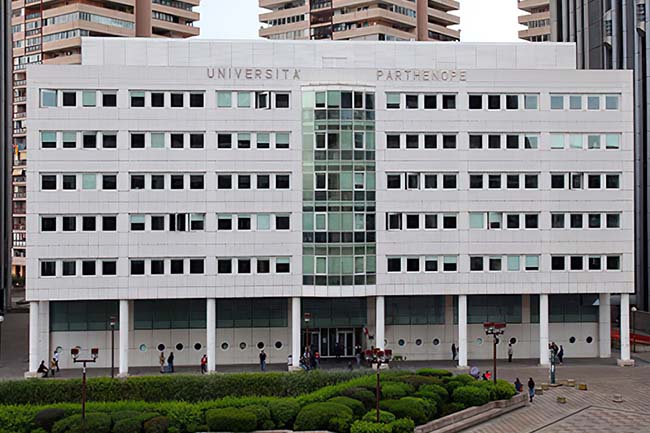The key words of this course are urban space and territory. These two elements are studied as environment of opportunities to be developed or as environment to be safeguarded from anthropic and natural risks. Moreover, teaching is enriched by case studies, allowing graduates to adapt immediately to the professional world.
Graduates can access positions in public administrations or find employment in construction or design companies or consultancy on environmental and territorial safety.
The key words of the course in Civil and Environmental Engineering for Risk Mitigation are urban space and territory. In a unified way, these are studied both as environments of opportunity where to develop and build, and as environments to be safeguarded from related natural and anthropogenic risks. Three good reasons to study civil and environmental engineering at Uniparthenope:
Course Duration: 3 years
Credits: 180
Admission: Open
Double Degree: No
Class Membership: L-7
Department: Engineering
The general structure of the course, based on the methodological rigour typical of scientific subjects, ensures that students learn, thanks also to sufficient time dedicated to personal study, about some of the most recent developments in their field.
In particular, graduates in Civil and Environmental Engineering for Risk Mitigation will have an adequate knowledge and understanding of the physical and mathematical tools that form the basis of Civil and Environmental Engineering, such as mathematical analysis, algebra and analytical geometry, general physics and mathematical physics, statics and dynamics of rigid bodies, and the fundamentals of subjects characterising Civil Engineering such as Construction Science and Technology, Geotechnics, Hydraulics, Hydraulic Constructions, Topography, and Sanitary and Environmental Engineering. The teaching approach common to all courses requires that theoretical training be constantly accompanied by examples, numerical and laboratory applications, individual and group work, and tests that encourage active participation, a proactive attitude, the ability to work independently, and the ability to communicate the results of the work carried out.
The general structure of the course, based on the methodological rigour typical of scientific subjects, ensures that students learn, thanks also to sufficient time dedicated to personal study, about some of the most recent developments in their field.
In particular, graduates in Civil and Environmental Engineering for Risk Mitigation will have an adequate knowledge and understanding of the physical and mathematical tools that form the basis of Civil and Environmental Engineering, such as mathematical analysis, algebra and analytical geometry, general physics and mathematical physics, statics and dynamics of rigid bodies, and the fundamentals of subjects characterising Civil Engineering such as Construction Science and Technology, Geotechnics, Hydraulics, Hydraulic Constructions, Topography, and Sanitary and Environmental Engineering. The teaching approach common to all courses requires that theoretical training be constantly accompanied by examples, numerical and laboratory applications, individual and group work, and tests that encourage active participation, a proactive attitude, the ability to work independently, and the ability to communicate the results of the work carried out.
All information about the course, from admission to the final exam, for all students interested in enrolling in the Bachelor’s Degree in Civil and Environmental Engineering for Risk Mitigation.
In order to successfully complete an Engineering Degree Course, students must possess basic scientific knowledge and verbal comprehension skills. The latter two aspects, which are particularly important for filling any gaps in the former, are closely related to the ability to read and interpret texts, organise and archive knowledge, self-assess, organise study activities and take responsibility for decisions made. However, as far as mathematics is concerned, engineering training must build on a previous educational foundation developed throughout the entire school career.
With this in mind, it is considered appropriate to provide detailed information on the essential knowledge of mathematics:
The Department of Engineering has specific agreements in place for internships with the following companies and public bodies:
Municipality of Cicciano (NA), Tecno In spa, TECNO SrL, METROPOLITANA DI NAPOLI, ASIA, Calderisi Group SrL, Municipality of Nocera Inferiore, ACEN – Associazione Costruttori Edili Napoli (Naples Builders’ Association), Campania Region Public Works Department, Municipality of Bacoli (NA), FIPA scarl, Stress S.c.a.r.l., Progest SpA, Elios Engineering srl, Air support srl, CNR – ITC, Supertech High Tech Brakes srl, INCOSIT SrL, CMD SpA, A&C Ecotech, Municipality of Naples, Kisters AG, PAPER DIVIPAC, C.I.R.A. SpA, KISTERS AG, ISTITUTO BANCO DI NAPOLI, ANEA Ag. Napoletana Energia e Ambiente. The course has also established an agreement for internships with Kisters AG, based in Germany, and with the Beijing University of Civil Engineering and Architecture (BUCEA).
The final examination consists of a discussion before a committee composed of at least seven lecturers of a written paper focusing on the content of at least one of the educational activities included in the teaching programme. The paper is prepared by the student under the guidance of a supervisor and may concern one or more of the following activities: – calculation, design or verification paper; bibliographic research. Typically, the supervisor is assigned at the request of the graduating student, who may indicate the subject in which they intend to take the final exam.
The assessment criteria for the final exam take into account the complexity of the paper, the mastery shown in the subject covered and the ability to present the material: these criteria are described in a specific regulation published on the Department of Engineering website.

BACHELOR’S DEGREE COURSE COORDINATOR:
Prof.ssa DELLA MORTE Renata
renata.dellamorte@uniparthenope.it

Centro Direzionale di Napoli, Isola C4 – 80143 Napoli
Università degli Studi di Napoli “Parthenope”
Via Amm. F. Acton, 38 – 80133 Napoli (NA)
P.IVA 01877320638 | C.F. 80018240632
2021 – Università degli Studi di Napoli Parthenope – All Right Reserved